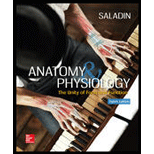
Anatomy & Physiology: The Unity of Form and Function
8th Edition
ISBN: 9781259277726
Author: Kenneth S. Saladin Dr.
Publisher: McGraw-Hill Education
expand_more
expand_more
format_list_bulleted
Concept explainers
Question
Chapter 14.4, Problem 14BYGO
Summary Introduction
Introduction:
The forebrain consists of two major parts namely diencephalon and telencephalon. The major three components of diencephalon are the thalamus, hypothalamus, and epithalamus; those arise in the embryonic development of the brain. Diencephalon connects the cerebrum and the posterior parts of the brain. The third ventricle is enclosed by the diencephalon.
Expert Solution & Answer
Want to see the full answer?
Check out a sample textbook solution
Students have asked these similar questions
How many ventricles are in the brain?
why do the ventricles contract inferior to superior?
What is the function of theleft ventricle? Where does theblood go after leaving the leftventricle?
Chapter 14 Solutions
Anatomy & Physiology: The Unity of Form and Function
Ch. 14.1 - Prob. 1BYGOCh. 14.1 - Define gyrus and sulcus.Ch. 14.1 - Prob. 3BYGOCh. 14.1 - Prob. 4BYGOCh. 14.1 - Prob. 1AYLOCh. 14.1 - Prob. 2AYLOCh. 14.1 - Prob. 3AYLOCh. 14.1 - Prob. 4AYLOCh. 14.1 - Prob. 5AYLOCh. 14.1 - Embryonic development of the brain from neural...
Ch. 14.2 - Prob. 5BYGOCh. 14.2 - Prob. 6BYGOCh. 14.2 - Prob. 7BYGOCh. 14.2 - Prob. 8BYGOCh. 14.2 - Prob. 1AYLOCh. 14.2 - Prob. 2AYLOCh. 14.2 - Prob. 3AYLOCh. 14.2 - Prob. 4AYLOCh. 14.2 - Prob. 5AYLOCh. 14.2 - Prob. 6AYLOCh. 14.2 - Prob. 7AYLOCh. 14.3 - Prob. 9BYGOCh. 14.3 - Prob. 10BYGOCh. 14.3 - Prob. 11BYGOCh. 14.3 - Prob. 12BYGOCh. 14.3 - Prob. 13BYGOCh. 14.3 - The medulla oblongata: its location, gross...Ch. 14.3 - Prob. 2AYLOCh. 14.3 - Prob. 3AYLOCh. 14.3 - Prob. 4AYLOCh. 14.3 - The cerebellum: its location, gross anatomy,...Ch. 14.3 - Prob. 6AYLOCh. 14.4 - Prob. 14BYGOCh. 14.4 - Prob. 15BYGOCh. 14.4 - List at least six functions of the hypothalamus.Ch. 14.4 - Prob. 17BYGOCh. 14.4 - Distinguish between commissural, association, and...Ch. 14.4 - Prob. 19BYGOCh. 14.4 - Prob. 20BYGOCh. 14.4 - Prob. 1AYLOCh. 14.4 - Prob. 2AYLOCh. 14.4 - Prob. 3AYLOCh. 14.4 - Prob. 4AYLOCh. 14.4 - Prob. 5AYLOCh. 14.4 - Prob. 6AYLOCh. 14.4 - Prob. 7AYLOCh. 14.4 - Prob. 8AYLOCh. 14.4 - Prob. 9AYLOCh. 14.4 - Prob. 10AYLOCh. 14.4 - Prob. 11AYLOCh. 14.4 - Prob. 12AYLOCh. 14.4 - Prob. 13AYLOCh. 14.5 - Prob. 21BYGOCh. 14.5 - Prob. 22BYGOCh. 14.5 - Prob. 23BYGOCh. 14.5 - Prob. 24BYGOCh. 14.5 - Prob. 1AYLOCh. 14.5 - Stages of sleep; physiological characteristics of...Ch. 14.5 - Association areas of the cerebral cortex; the...Ch. 14.5 - Prob. 4AYLOCh. 14.5 - Prob. 5AYLOCh. 14.5 - Prob. 6AYLOCh. 14.5 - Prob. 7AYLOCh. 14.5 - Prob. 8AYLOCh. 14.5 - Prob. 9AYLOCh. 14.5 - Prob. 10AYLOCh. 14.5 - Prob. 11AYLOCh. 14.5 - Effect of Parkinson disease and basal nuclei...Ch. 14.5 - Prob. 13AYLOCh. 14.5 - Prob. 14AYLOCh. 14.6 - Prob. 25BYGOCh. 14.6 - Prob. 26BYGOCh. 14.6 - Prob. 27BYGOCh. 14.6 - Prob. 28BYGOCh. 14.6 - Prob. 29BYGOCh. 14.6 - Prob. 1AYLOCh. 14.6 - Prob. 2AYLOCh. 14.6 - Prob. 3AYLOCh. 14.6 - Prob. 4AYLOCh. 14 - Which of these is caudal to the hypothalamus? a....Ch. 14 - If the telencephalon was removed from a 5-week-old...Ch. 14 - The blood-CSF barrier is formed by a. blood...Ch. 14 - Prob. 4TYRCh. 14 - Which of the following does not receive any input...Ch. 14 - Prob. 6TYRCh. 14 - Prob. 7TYRCh. 14 - The_________is most closely associated with the...Ch. 14 - Prob. 9TYRCh. 14 - Prob. 10TYRCh. 14 - The right and left cerebral hemispheres are...Ch. 14 - Prob. 12TYRCh. 14 - Prob. 13TYRCh. 14 - Prob. 14TYRCh. 14 - Prob. 15TYRCh. 14 - Prob. 16TYRCh. 14 - Prob. 17TYRCh. 14 - Prob. 18TYRCh. 14 - Prob. 19TYRCh. 14 - Prob. 20TYRCh. 14 - Prob. 1BYMVCh. 14 - Prob. 2BYMVCh. 14 - Prob. 3BYMVCh. 14 - Prob. 4BYMVCh. 14 - Prob. 5BYMVCh. 14 - Prob. 6BYMVCh. 14 - Prob. 7BYMVCh. 14 - oculo-Ch. 14 - Prob. 9BYMVCh. 14 - Prob. 10BYMVCh. 14 - Prob. 1WWTSCh. 14 - Prob. 2WWTSCh. 14 - Prob. 3WWTSCh. 14 - Prob. 4WWTSCh. 14 - Prob. 5WWTSCh. 14 - Prob. 6WWTSCh. 14 - Prob. 7WWTSCh. 14 - Prob. 8WWTSCh. 14 - Prob. 9WWTSCh. 14 - Prob. 10WWTSCh. 14 - Prob. 1TYCCh. 14 - Prob. 2TYCCh. 14 - Suppose that a neuroanatomist performed two...Ch. 14 - A person can survive destruction of an entire...Ch. 14 - Prob. 5TYC
Knowledge Booster
Learn more about
Need a deep-dive on the concept behind this application? Look no further. Learn more about this topic, biology and related others by exploring similar questions and additional content below.Similar questions
- What do the ventricles contain? A. Densely packed neuron cell bodies B. Glia C. Cerebrospinal fluid D. Long axonsarrow_forwardif the impulse is coming inferiorly from the SA node then how do the ventricles contract inferior to superior?arrow_forwardDifferentiate between right ventricle and left ventricle.arrow_forward
- What effect will an increase in sympathetic activity have on heart rate, force of contraction, and arteriolar diameter?arrow_forwardTwo thalami are joined across the slit of the 3rd ventricle by the a. Septum b. Periventricular nuclei c. Mass intermedia d. Arcuate fasciculusarrow_forwardWhich nerves of the body carry ANS fibers that innervate the SA and AV nodes of the heart? Which of the nerves you listed carry sympathetic fibers and which carry parasympathetic fibers? What is the effect of increased sympathetic impulses on heart rate? What about increased parasympathetic impulses?arrow_forward
arrow_back_ios
SEE MORE QUESTIONS
arrow_forward_ios
Recommended textbooks for you
 Fundamentals of Sectional Anatomy: An Imaging App...BiologyISBN:9781133960867Author:Denise L. LazoPublisher:Cengage Learning
Fundamentals of Sectional Anatomy: An Imaging App...BiologyISBN:9781133960867Author:Denise L. LazoPublisher:Cengage Learning Human Physiology: From Cells to Systems (MindTap ...BiologyISBN:9781285866932Author:Lauralee SherwoodPublisher:Cengage Learning
Human Physiology: From Cells to Systems (MindTap ...BiologyISBN:9781285866932Author:Lauralee SherwoodPublisher:Cengage Learning

Fundamentals of Sectional Anatomy: An Imaging App...
Biology
ISBN:9781133960867
Author:Denise L. Lazo
Publisher:Cengage Learning

Human Physiology: From Cells to Systems (MindTap ...
Biology
ISBN:9781285866932
Author:Lauralee Sherwood
Publisher:Cengage Learning
12 Organ Systems | Roles & functions | Easy science lesson; Author: Learn Easy Science;https://www.youtube.com/watch?v=cQIU0yJ8RBg;License: Standard youtube license